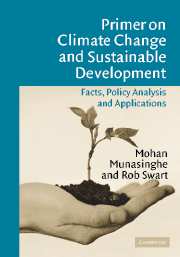Book contents
- Frontmatter
- Contents
- Foreword
- Preface
- 1 Climate change: scientific background and introduction
- 2 Future scenarios of development and climate change
- 3 Framework for making development more sustainable (MDMS): concepts and analytical tools
- 4 Interactions between climate and development
- 5 Adaptation to climate change: concepts, and linkages with sustainable development
- 6 Vulnerability, impacts, and adaptation by sectors and systems
- 7 Vulnerability, impacts, and adapation by geographic region
- 8 Mitigating climate change: concepts and linkages with sustainable development
- 9 Mitigation measures: technologies, practices, barriers, and policy instruments
- 10 Assessment of mitigation costs and benefits
- 11 Climate change and sustainable development: a synthesis
- Index
- References
7 - Vulnerability, impacts, and adapation by geographic region
Published online by Cambridge University Press: 25 December 2009
- Frontmatter
- Contents
- Foreword
- Preface
- 1 Climate change: scientific background and introduction
- 2 Future scenarios of development and climate change
- 3 Framework for making development more sustainable (MDMS): concepts and analytical tools
- 4 Interactions between climate and development
- 5 Adaptation to climate change: concepts, and linkages with sustainable development
- 6 Vulnerability, impacts, and adaptation by sectors and systems
- 7 Vulnerability, impacts, and adapation by geographic region
- 8 Mitigating climate change: concepts and linkages with sustainable development
- 9 Mitigation measures: technologies, practices, barriers, and policy instruments
- 10 Assessment of mitigation costs and benefits
- 11 Climate change and sustainable development: a synthesis
- Index
- References
Summary
From the regional viewpoint, developing countries lying within the tropical areas are the most sensitive and vulnerable to climate change impacts. Many ecosystems in poorer countries are already under stress, and climate change impacts will further exacerbate the situation. Social and economic systems are also more vulnerable, because income levels are lower (including limited funds, human resources, and skills), and political, institutional, and technological support systems are weaker than in the industrialized world. An important implication is that adaptive capacity must be strengthened significantly, especially in the poorest and most vulnerable regions and countries. In this chapter, we will show that strengthening adaptive capacity generally is fully consistent with achieving broader development objectives.
The status of the major regions of the world, with reference to vulnerability, impacts, and adaptation, is reviewed briefly in this chapter. Necessarily, there is some overlap with the generic, sectoral approach of the previous chapter, but we make an attempt in this chapter to focus on adaptation options that may be of specific priority for the various regions.
Africa
Vulnerability
Because of the endemic poverty and the reliance of the rapidly growing population on natural resources and agriculture for the provision of basic needs and economic production (UNEP 2002), Africa is particularly vulnerable to environmental changes. Land degradation, deforestation, habitat degradation, water stress and scarcity, coastal area erosion and degradation, floods and droughts, and armed conflict, are some of the key environmental problems in Africa that hamper development.
- Type
- Chapter
- Information
- Primer on Climate Change and Sustainable DevelopmentFacts, Policy Analysis, and Applications, pp. 231 - 268Publisher: Cambridge University PressPrint publication year: 2005



